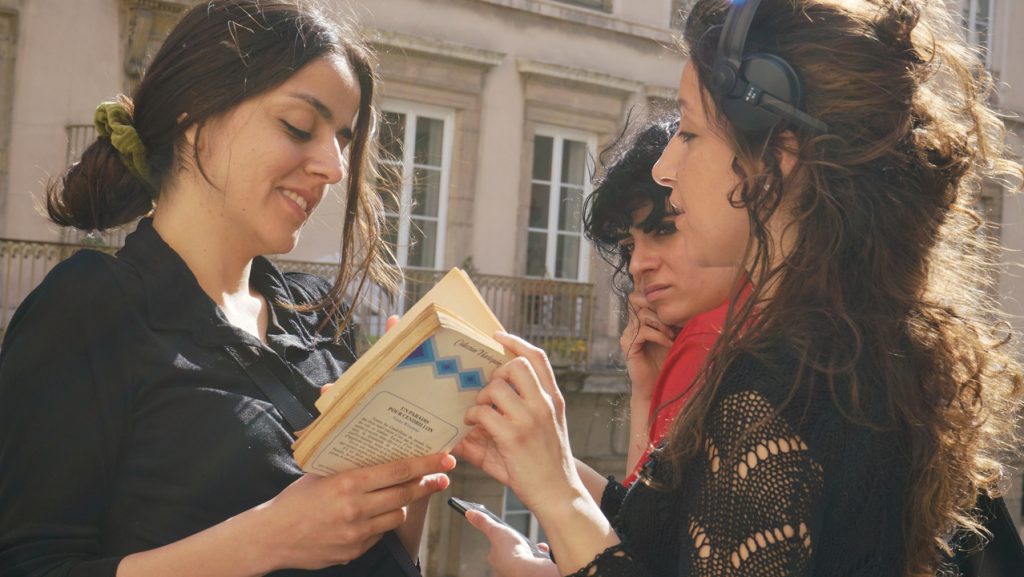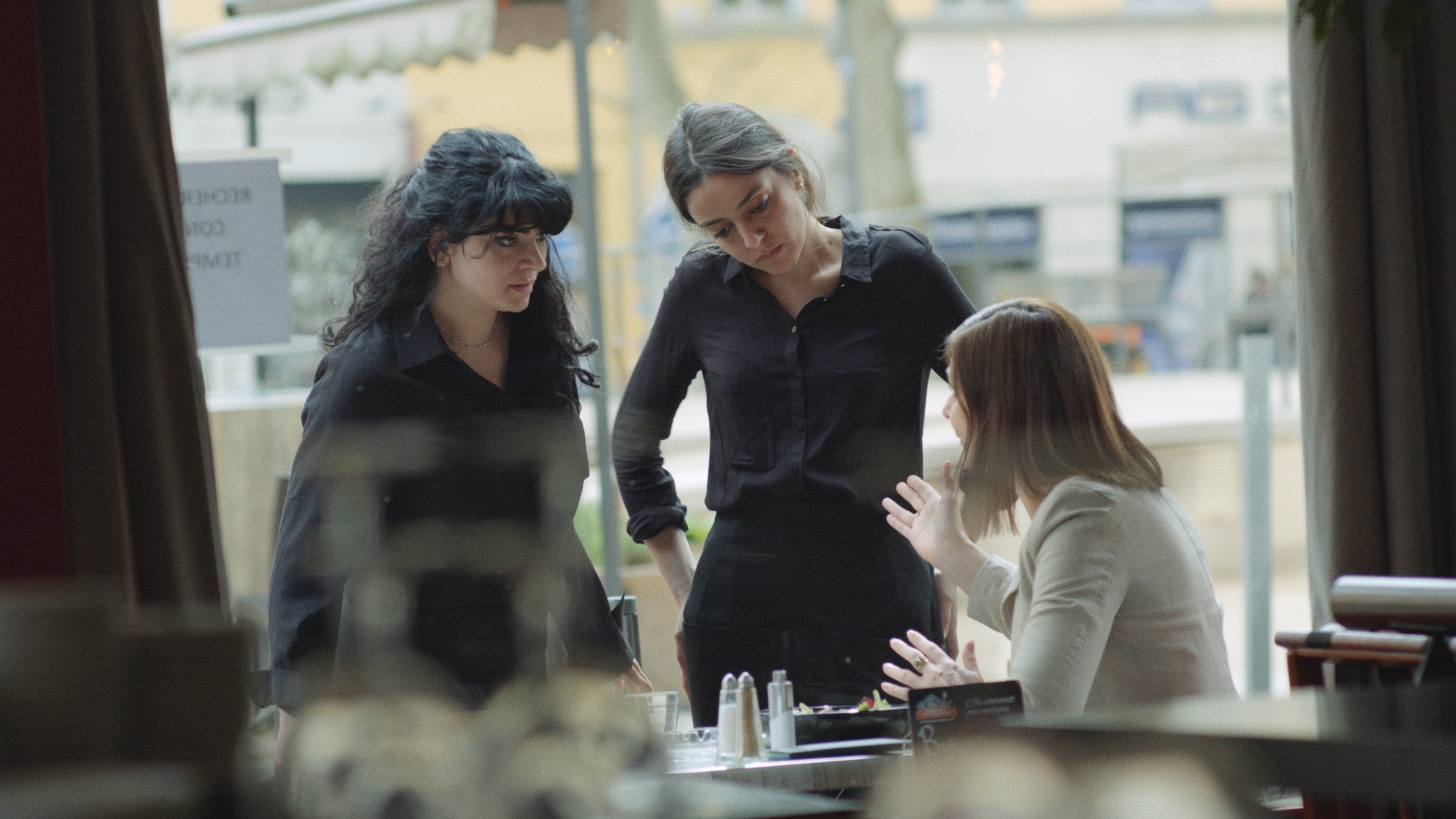The Caterpillar’s Journey
Noel Keserwany on Golden Bear Winner Les Chenilles
In Les Chenilles, two women originally from the Levant find themselves working in the same restaurant Lyon. Both bear the weight of a home they were forced to leave behind. Initially wary of each other, they gradually discover a common thread that binds them.

Noel and Michelle Keserwany share a deep connection to their homeland. Raised in Lebanon, they were brought up in the country’s vibrant culture and were quickly drawn to artistic pursuits as a way of addressing their nation’s increasingly challenging environment. But in 2019, Michelle’s journey led her to Paris, where Noel joined her in 2021: Lebanon’s multilayered political and social crises meant creating, yet alone living, became difficult and the sisters were lucky enough to establish a new home in France.
Michelle and Noel’s artistic journey is unconventional. Neither received formal education in filmmaking, but they studied advertising, which they quickly realised was not what they wanted to do. Their taste was for storytelling, illustration, creating comics, and songwriting. A decade ago, they discovered the power of political music videos to express their frustrations with the complexities of Lebanese life. A viral video allowed them to try new means of expression and the sisters carved out a unique niche for themselves, made of pixelated YouTube clips and other carefully crafted sequences. Although political music videos remain a vital outlet for them, cinema now provides a larger canvas to voice their experiences.
Les Chenilles, their first short, premiered at Berlinale Shorts, where it won the Golden Bear, before screening at many other festivals, including Concorto, where I got to talk with Noel Keserwany.
Les Chenilles tells the story of Asma and Sarah, both waitresses in France but originally from the Levant, against the backdrop of a broader history of silk production. How did these ideas come together?
The film takes root in two things. You know what it’s like when you’re trying to get your head around a really intense feeling you’re dealing with—that’s where it all begins. It takes the form of a personal journey, which is like our own experience: leaving our hometown and landing in Paris. That journey introduced us to so many people and feelings that we just had the need to dive deeper into. This personal need is all over the film. Then, through research with the support of La Biennale de Lyon, we were able to look at a vast number of archives, books and articles about silk production between France and the Levant. We stumbled upon an article by Faraz Traboulsi, “An Amour de Soie”, in which he writes about the late 1800s, when French silk factories moved to the Levant because of problems: the silkworms needed new fields. And that’s where Lebanon and Syria come in.
The article gave us the lowdown on colonialism’s internal politics: how work was divided along lines of gender and migration back then. We felt these themes reflected our contemporary political situation perfectly. Silk production impacted the country from both inside and outside. A lack of economic planning and the greed of people in power within Lebanon allowed external investors to come in. But this resulted in a huge financial crisis that caused the death of a large number of people and triggered the first wave of migration… Michelle and I are part of this ongoing story of displacement.
How did working in Lyon influence the story you wanted to tell?
The film was made as part of the 2023 Biennale de Lyon. We find out that Lyon had a significant role in the 19th-century silk trade between France and the Levant and that monuments are dedicated to this history throughout the city. So it made sense to film there. Michelle and I visited Lyon twice for scouting and discovered the city in more depth. These visits definitely shaped the story. Every little detail is connected, and the intention behind the film dictates everything, from the location to the narrative to the music and visuals. We also went around with Karim Ghoreib, the talented DOP with whom we have worked on several projects before. The Biennale de Lyon and Dewberries Films produced the film, but no one ever asked us to shoot in Lyon; they just gave us such great support and respected our creative process.
There is a very moving scene in which a waitress drops a tray full of glasses in front of customers, who make the most of the confusion and run away without paying. This seems to touch on colonialism and the idea of non-white people serving white people without being treated fairly. Am I overinterpreting?
No, this is not what we intended to symbolise in this scene. The Lebanese context is a blend between historical interference in our region and the role of political elites within the country: the Lebanese political class can be corrupt, prioritising personal gain over the welfare of the country. This allows external and internal influences to disrupt the nation. So, I think it’s a complex mix of factors and I would not simply blame white people for that. The film addresses both the outside and inside forces that have led to this instability. It isn’t just about serving customers; it’s about the inner instability one feels upon arriving in a new country. The scene with the glasses breaking reflects the characters’ individual histories. When you delve into Sarah’s past later in the film, you see that the shattered glass triggers memories tied to her experiences back home. It’s a constellation of elements, not a single perspective.
The film opens with a captivating story about caterpillars kept between women’s breasts for warmth. The shots of breasts offer a fresh perspective on women’s bodies and their relationship to labour. The imagery conveys the discomfort, but it’s not disturbing.
Finding the right balance between displaying the intimate images and the unsettling content was a process driven by our connection to our bodies as women. We intended to express the disturbing aspect without overwhelming or overexposing the women in the shots. The shot aimed to tell precisely what we needed to convey without the need for excess: words and visuals work in tandem, with a voiceover narration relating the historical facts. We wanted to unsettle while keeping it subtle because it’s not about pushing a specific agenda but creating a unique gaze. Perhaps the answer lies in women directing women: building a perspective from lived experiences.

Les Chenilles
The film beautifully explores bonds between women, embracing sisterhood in a broad sense. When did the idea of co-directing with your sister come about?
Our collaborative journey spans a decade of crafting music videos together. When the Biennale de Lyon approached us for a project, co-directing felt natural. Our dynamic as sisters who understand each other meant we could divide tasks effectively to amplify our creative power. Michelle focused on writing, and I took on an acting role.
Both of the main protagonists are played by charismatic actors. And you’re one of them. Was it always clear you would act in the film? And what was it like to be directed by your sister?
It was clear that it would help if I played the role of Sarah, a girl who just arrived in France from Lebanon, which was my own case. Acting felt like an extension of the storytelling, another way of pushing the story further. It was my first time, and I wouldn’t have done it without Michelle. I trust her fully, not just because she is my sister, but because I think she’s extremely talented. Besides, we have been working together for over ten years and understand each other well. On set, we both knew that we were aligned and I had no doubts that we would get what we needed.
Did you plan the film’s duration, or did it naturally develop into its almost 30-minute length? Festivals often have specific preferences for film duration…
When we start our projects, it begins with understanding the intense emotions we’re experiencing. What are we really trying to convey and explore? We delve into research, speaking with individuals who’ve gone through similar experiences, including historians and people who aren’t involved in cinema. This practical research shapes the plot. When Michelle wrote the script, we felt the length was crucial to express the story fully. The genre and duration should serve the content, not the other way around.
As newcomers to cinema, we don’t want to be confined by accepted norms. Our authenticity drives us; we involve others to ensure we’re not working in a bubble. We don’t feel bound by strict conventions. People suggested shortening it, questioning the thirty-minute duration and festival habits, etc. But we felt the story needed this length. Our selection at the Berlinale, our first festival, was reassuring. The length we chose was right, and we were so surprised when the film won the Golden Bear. We didn’t expect it! We just remained dedicated to what the story needed.
